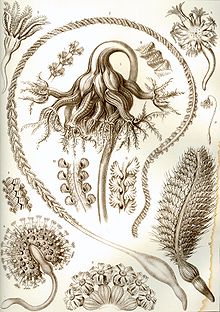Pennatulacea
| Sea pens Temporal range: Cambrian–Recent |
|
|---|---|
 |
|
| "Pennatulida" from Ernst Haeckel's Kunstformen der Natur, 1904 | |
| Scientific classification | |
| Kingdom: | Animalia |
| Phylum: | Cnidaria |
| Class: | Anthozoa |
| Subclass: | |
| Order: |
Pennatulacea Verrill, 1865 |
| Families | |
|
|
Sea pens are colonial marine cnidarians belonging to the order Pennatulacea. There are 16 families within the order; they are thought to have a cosmopolitan distribution in tropical and temperate waters worldwide. Sea pens are grouped with the ("soft corals"), together with sea whips or gorgonians.
Although named after their feather-like appearance reminiscent of antique quill pens, only sea pen species belonging to the suborder Subselliflorae live up to the comparison. Those belonging to the much larger suborder Sessiliflorae lack feathery structures and grow in club-like or radiating forms. The latter suborder includes what are commonly known as sea pansies.
The earliest accepted fossils are known from the Cambrian-aged Burgess Shale (Thaumaptilon). Similar fossils from the Ediacaran (ala Charnia) may represent the dawn of sea pens. Precisely what these early fossils are, however, is not decided.
As octocorals, sea pens are colonial animals with multiple polyps (which look somewhat like miniature sea anemones), each with eight tentacles. Unlike other octocorals, however, a sea pen's polyps are specialized to specific functions: a single polyp develops into a rigid, erect stalk (the rachis) and loses its tentacles, forming a bulbous "root" or peduncle at its base. The other polyps branch out from this central stalk, forming water intake structures (siphonozooids), feeding structures (autozooids) with , and reproductive structures. The entire colony is fortified by calcium carbonate in the form of spicules and a central axial rod.
Using their root-like peduncles to anchor themselves in sandy or muddy substrate, the exposed portion of sea pens may rise up to 2 metres (6.6 ft) in some species, such as the tall sea pen (Funiculina quadrangularis). Sea pens are sometimes brightly coloured; the orange sea pen (Ptilosarcus gurneyi) is a notable example. Rarely found above depths of 10 metres (33 ft), sea pens prefer deeper waters where turbulence is less likely to uproot them. Some species may inhabit depths of 2,000 metres (6,600 ft) or more.
...
Wikipedia
